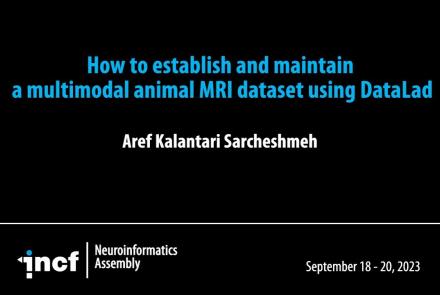This lecture describes the neuroscience data respository G-Node Infrastructure (GIN), which provides platform independent data access and enables easy data publishing.
Difficulty level: Beginner
Duration: 22:23
Speaker: : Michael Sonntag
This lesson provides an introduction to the course Neuroscience Data Integration Through Use of Digital Brain Atlases, during which attendees will learn about concepts for integration of research data, approaches and resources for assigning anatomical location to brain data, and infrastructure for sharing experimental brain research data.
Difficulty level: Beginner
Duration: 14:02
Speaker: : Trygve Leergard
This talk covers the various concepts, motivations, and trends within the neuroscientific community related to the sharing and integration of brain research data.
Difficulty level: Beginner
Duration: 30:39
Speaker: : Jan G. Bjaalie
This lesson focuses on the neuroanatomy of the human brain, delving into macrostructures like cortices, lobes, and hemispheres, and microstructures like neurons and cortical laminae.
Difficulty level: Beginner
Duration: 51:30
Speaker: : Nicola Palomero-Gallagher
This lesson provides an introduction to the European open research infrastructure EBRAINS and its digital brain atlas resources.
Difficulty level: Beginner
Duration: 27:45
Speaker: : Trygve Leergard
In this lesson, attendees will learn about the challenges in assigning experimental brain data to specific locations, as well as the advantages and shortcomings of current location assignment procedures.
Difficulty level: Beginner
Duration: 32:18
Speaker: : Ingvild Elise Bjerke
This lesson covers the inherent difficulties associated with integrating neuroscientific data, as well as the current methods and approaches to do so.
Difficulty level: Beginner
Duration: 25:41
Speaker: : Trygve Leergard
Attendees of this talk will learn about QuickNII, a tool for user-guided affine registration of 2D experimental image data to 3D atlas reference spaces, which also facilitates data integration through standardized coordinate systems.
Difficulty level: Beginner
Duration: 21:08
Speaker: : Maja Puchades
This lesson provides an overview of DeepSlice, a Python package which aligns histology to the Allen Brain Atlas and Waxholm Rat Atlas using deep learning.
Difficulty level: Beginner
Duration: 17:30
Speaker: : Harry Carey
This lecture covers the history of behaviorism and the ultimate challenge to behaviorism.
Difficulty level: Beginner
Duration: 1:19:08
Speaker: : Paul F.M.J. Verschure
This talk describes how to use DataLad for your data management and curation techniques when dealing with animal datasets, which often contain several disparate types of data, including MRI, microscopy, histology, electrocorticography, and behavioral measurements.
Difficulty level: Beginner
Duration: 3:35
Speaker: : Aref Kalantari Sarcheshmeh
In this short talk you will learn about The Neural System Laboratory, which aims to develop and implement new technologies for analysis of brain architecture, connectivity, and brain-wide gene and molecular level organization.
Difficulty level: Beginner
Duration: 8:38
Speaker: : Trygve Leergard
Course:
In this lecture, attendees will learn how Mutant Mouse Resource and Research Center (MMRRC) archives, cryopreserves, and distributes scientifically valuable genetically engineered mouse strains and mouse ES cell lines for the genetics and biomedical research community.
Difficulty level: Beginner
Duration: 43:38
Speaker: : Kent Lloyd
This lecture discusses how to standardize electrophysiology data organization to move towards being more FAIR.
Difficulty level: Beginner
Duration: 15:51
Speaker: : Sylvain Takerkart
This lecture covers a lot of post-war developments in the science of the mind, focusing first on the cognitive revolution, and concluding with living machines.
Difficulty level: Beginner
Duration: 2:24:35
Speaker: : Paul F.M.J. Verschure
This brief talk goes into work being done at The Alan Turing Institute to solve real-world challenges and democratize computer vision methods to support interdisciplinary and international researchers.
Difficulty level: Beginner
Duration: 7:10
Speaker: : Alden Connor & Beatriz Costa Gomes
This lesson aims to define computational neuroscience in general terms, while providing specific examples of highly successful computational neuroscience projects.
Difficulty level: Beginner
Duration: 59:21
Speaker: : Alla Borisyuk
Course:
This lecture gives an introduction to simulation, models, and the neural simulation tool NEST.
Difficulty level: Beginner
Duration: 1:48:18
Speaker: : Marc-Oliver Gewaltig
Course:
This lecture covers an Introduction to neuron anatomy and signaling, and different types of models, including the Hodgkin-Huxley model.
Difficulty level: Beginner
Duration: 1:23:01
Speaker: : Gaute Einevoll
This lecture covers an Introduction to neuron anatomy and signaling, and different types of models, including the Hodgkin-Huxley model.
Difficulty level: Beginner
Duration: 1:23:01
Speaker: : Gaute Einevoll
Topics
- Artificial Intelligence (6)
- Philosophy of Science (5)
- Provenance (2)
- protein-protein interactions (1)
- Extracellular signaling (1)
- (-) Animal models (6)
- Assembly 2021 (29)
- Brain-hardware interfaces (13)
- Clinical neuroscience (17)
- International Brain Initiative (2)
- Repositories and science gateways (11)
- Resources (6)
- General neuroscience
(45)
- Neuroscience (9)
- Cognitive Science (7)
- Cell signaling (3)
- Brain networks (4)
- Glia (1)
- Electrophysiology (16)
- Learning and memory (3)
- Neuroanatomy (17)
- Neurobiology (7)
- Neurodegeneration (1)
- Neuroimmunology (1)
- Neural networks (4)
- Neurophysiology (22)
- Neuropharmacology (2)
- Synaptic plasticity (2)
- Visual system (12)
- Phenome (1)
- General neuroinformatics
(15)
- (-) Computational neuroscience (192)
- Statistics (2)
- Computer Science (15)
- Genomics (25)
- Data science
(24)
- Open science (52)
- Project management (7)
- Education (3)
- Publishing (4)
- (-) Neuroethics (35)



















